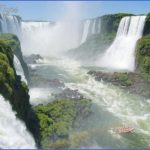Pypore
La Huella Fransiscana (translated as the Franciscan footprint) is a recent tourism project developed by the NGO Fundacion Tierra Nuestra to improve and increase tourism in Paraguay’s Franciscan towns. So far the project has yielded a packaged tour that combines both the religious aspect of the Fransiscan route and the artesanal traditions still maintained in Franciscan towns. The tour starts with a visit to the church of Yaguaron after which the group walks to the nearby Museo Gaspar Rodriguez de Francia, accompanied all the while by a small procession of a traditional indigenous peteke peteke band. Next is a visit to a nanduti workshop in Itagua where visitors can observe and even partake in the creation of delicate lace designs. The day ends with a meal of traditional Paraguayan foods in Aregua followed by a visit to a ceramic workshop and a stop by the lovely Centro Cultural del Lago. All in all a culturally packed day with an itinerary (and comfort level) that would be impossible to replicate on public transportation. Tours cost US$80 per person with scheduled departure dates approximately two weekends per month. Call or email COTUR for information on upcoming tours and reservations (must be made one week in advance although last minute spots are sometimes avaliable). Other excursions such as visits to patron saint festivals are in the works. Tel: 021 204 775, 021 204 778, Pypore-
lahuellafranciscana@tierranuestra.org.py or info@cotur.com.py
Departamento Central
Due to their proximity to the capital city the towns of the Central department have largely become satellite cities to Asuncion. A significant part of the population of Central commutes daily to Asuncion. As a result, buses from Central tend to be packed tight during the mornings and afternoons. The further you get from Asuncion, the more pleasant these towns become. Located on the banks of the Lake Ypacaraf, Aregua is particularly nice and often visited by tourists and day trippers from Asuncion.
Capiata
Museo Mitologico Ramon Elias
The creatures of Paraguayan mythology (see Meet the Mitos) come to life in this museum created by local artist Ramon EHas. The statues were created based on interviews Ramon EHas did with Paraguayans throughout the countryside. Some are cartoonish in nature while other creatures are rendered in more frightening fashion. Though interesting the museum may not be worth a visit on its own as many similar sculptures of the mitos can be found outside the Folklore store in Asuncion (corner of Mariscal Estigarribia and Iturbe). The museum also has a number of statues from the Jesuit and Franciscan era, though the collection was greatly reduced following a robbery in 2009 (see Art Theft). Those with a particular interest in religious art should continue on to the town’s Franciscan church (open between 4pm-6pm) which has a lovely interior, second only to Paraguay’s most important Franciscan church in Yaguaron. Tel: 0228 634 262, Rt 2 km 19, one km before the entrance to Capiata on the left-hand side (if coming from Asuncion), Mon-Sat 8am-11:30am, 2:30pm-5pm, Sun 7:30am-12pm, Gs. 5,000
Itagua
Itagua is the home of Paraguay’s most emblematic artisanal tradition, nanduti. Creating the delicate spiderweb-like designs is a lengthy and laborious process. First a piece of cloth is sewn to a wooden frame or bastidor and stretched tight. The general shape of the final design is drawn on to this canvas. Each design is known as a dechado. There are over 160 popular dechados, though artisans also invent their own. Most dechados take their inspiration from the natural world emulating flowers, trees, and animals. Common dechados include those modeled after the passion fruit flower, the guava flower, the fish bone and the machete. These are painstakingly sewn on to the cloth with either sewing thread, for the more delicate nanduti de hilo fino (fine thread) or embroidery thread for nanduti de hilo grueso (thick thread). Traditionally only white thread was used but nowadays nandutis are an explosion of color. Once the dechados are complete, the piece is snipped free from the bastidor. It is then dampened with a mixture of water and starch and ironed dry to give it a slightly stiff body.
Popular nanduti items include table linens and traditional Paraguayan dance costumes. Prices are shockingly low when you take into consideration the amount of time and labor that goes into making these intricate nanduti pieces. Although the majority of the town’s artisans make nanduti, none are able to survive on nanduti production alone. Because dechados can be stitched together to form larger pieces many nanduti articles are made by several artisans, reducing the amount of time it takes to complete a finished piece. A full, ankle length skirt for a dance costume will take one person two months to complete (if working on it exclusively) whereas five artisans working together part-time can finish it in a month. This will sell for approximately Gs. 1,500,000 which must then be distributed amongst the artisans and salesperson. Large and elaborate tablecloths (manteles) run about Gs. 750,000 while smaller runners (camineros) and doilies (carpetas) can cost as little as Gs. 50,000. Individual dechados which can be used for appliques cost as little as Gs. 5,000. Nanduti de hilo fino is very delicate and commands between three and four times as much as the also beautiful but less labor intensive nanduti de hilo grueso. Many artisans also sell nanduti designs still on the bastidor which can also serve as a rustic frame.
Paraguay Travel Photo Gallery
Maybe You Like Them Too
- The Best Cities To Visit in The World
- World’s 10 Best Places To Visit
- Coolest Countries in the World to Visit
- Travel to Santorini, Greece
- Map of Barbados – Holiday in Barbados








